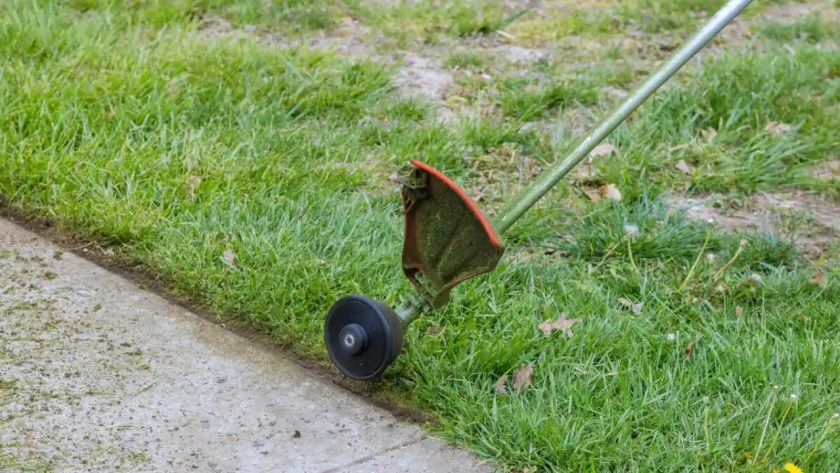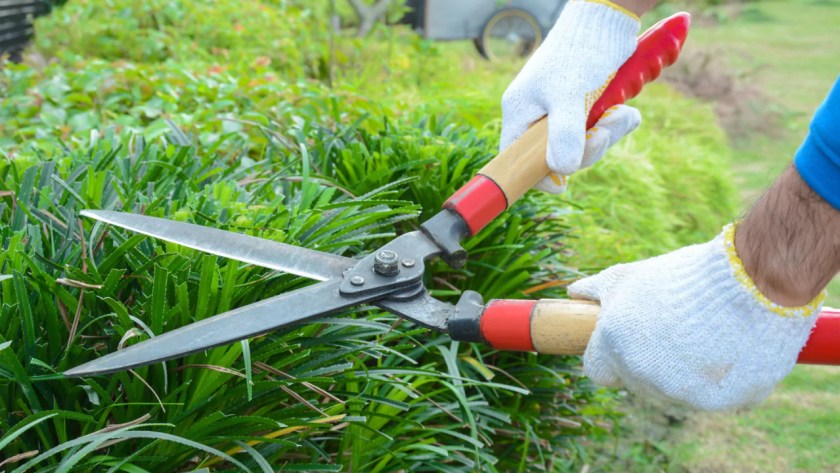Using a push or riding mower is the easiest method for mowing a lawn when trying to cut tall grass. However, if it is not an option, there are numerous ways to trim and maintain a lawn.
For example, you might use a string trimmer, hedge trimmer, scythe, or shears. Some of these methods are not as commonly used anymore, but you still have the ability to cut grass and maintain a lawn.
The keys to getting the most out of these methods is patience and safety. Your lawn will look the best if you take your time, learn to correctly use the tool you chose, and create an even path to mow whenever possible.
This is a way to have the neat, even look of mowed grass without needing to start up a large, loud mower that takes up space.
4 Ways to Cut Tall Grass Without a Mower
1. Using String Trimmer

A string trimmer is one of the simplest and creative alternatives to a lawnmower since it functions well and is powerful.
Just a word of caution, of course, you do get what you pay for with a grass trimmer. The one I reviewed below will only go through shorter grass.
Step 1: Only if your weed whacker is gas-powered, make sure to fill the tank with gas or if it is electric, plug it into an outdoor outlet with a heavy-duty outdoor extension cable. After filling, remember to (first) press the safety button of the whacker, once activated, you can now start the whacker.
Step 2: Come contact the grass to the trimmer’s head and slightly swing the whackers head to the side while taking little steps forward. For support swing the whacker’s head while keeping the handle snug against your hip.
Step 3: If you have tall grass, you can make contact a little higher the string head, approximately 8″ – 10″ from the ground, make an effort to maintain this height throughout to achieve that fancy trim or desired uniform height across the grass.
Step 4: As you go, overlap your mow slightly to ensure the height of the grass is the same throughout the process. After completing a swatch, turn and begin a second swatch parallel to the first, and slightly overlapping the swatch of your last mow at the end of your first path. Continue to cut, overlapping stings until the grass becomes uniform.
Step 5: After completing the mow, clean and store the weed whacker for further use in your collection.
2. Using Scythe

A scythe is an oversized piece of metal with a long handle connected to one end of the blade. It has a long metal blade that is curved and sharp on both sides. The best aspect of this tool is its ability to work well no matter how tall the grass may be.
However, it takes a lot of work and physical power to use this tool. You should also be very careful as the blade is sharp when using it to mow your lawn.
Here are the steps of the basic operation:
Step 1: Before you begin the process, be sure the edges of the blade are razor-sharp. After you’ve examined this, hold the top handle of your scythe with your left hand and the center handle in your right hand. Bend your knees and straighten your back.
Step 2: Extend your arms and lay the blade of the scythe flat on the ground. The blade will naturally tip up slightly from the ground, and the back of the blade will be flat on the ground.
Step 3: You must have your feet planted on the earth and twist your torso so that the blade of the scythe has been moved to the right and somewhat behind you.
Step 4: Start to make a swinging motion from front to back and back to front full body motion while using the muscles of your hips and thighs and move through the grass. For best results, from front to back and back to front the scythe should be parallel with the ground so that the blade cuts evenly each time.
Step 5: Finally, watch the large piece of metal you call a blade. It is best to watch the blade or you will end up with ambiguous cuts at the end. Continue to move forward when it is a time to cut the thick grass till the area is completely clear.
3. Using Hedge Trimmer

Alternatively, you can use a hedge trimmer. This trimmer is nearly identical to the weed trimmer, of which there are a couple of key variances.
It has nearly the same appearance and ability to cut (depending on what you may call a cutting ability) as a chainsaw, except the blade and/or mechanism may be different.
To maximize output, I suggest you follow these steps:
Step 1: As with any time you start the hedge trimmer you will grab the handles with both hands to start the device. You will then positions the blade into the grass on one side of your position. You will want to keep the blade parallel to the ground and horizontal to it as well, but simply move the hedge trimmer in steady motion as you sweep it around and throw the grass.
Step 2: No matter what, do not cut to close to the soil, whether it be more for a weed or grass, because the finish cut will never analyzed like a lawnmower produces.
Step 3: You will want the blade to move slowly! It”s especially important if you have thick grass because it will put your trimmer to the test, so take your time and let it work. You will feel and know this is especially important to not cut too fast to the soil while thassimilar to mowing procedure.
Step 4: If you want to have an aesthetically pleasing result, you have to be still and try cutting a bit and be ok with just taking some short breaks.
4. Using Shears

Shears are large scissors you will need both hands to operate. They consist of a pair of sharp blades that pivot past each other, joined in an angle. They have two handles at the neutral of the blades to operate the blades.
Shears are one of the best ways to cut tall grass and the best part of using shears is that it has a great degree of accuracy and a very pleasing an satisfying result to your trimming session.
Follow these steps to use Shears effectively.
Step 1: You will first want to wear elbow guards and knee pads or something similar to protect your knees and elbows. You will want to kneel or get your elbows involved to cut the grass to the desired height.
Step 2: Make sure your grip is comfortable to properly cut the grass.
Step 3: You will want to hold the handle like a scythe with the blades parallel to the ground and place the grass in between the blades and compress the shear handles to close the blades to cut the grass.
Step 4: Cutting little pieces of grass at a time. It’s ok if it take a little longer. The accurate tool is worth the time.
Step 5: Keep movement slow as you move around the yard and take breaks.
Safety Precautions When Tackling Overgrown Lawn
Choose the appropriate season: Tall grass should be cut during the summer or spring. Regardless of how lush, NEVER cut your green grass during the winter. Cutting in the winter will reduce the grass’s ability to recover.
Additionally, when you cut your grass when it is dry, you will minimize the chances of bacteria and diseases taking hold.
Look over the yard: This is important because long grass can hide a lot of items: branches, rocks, etc. If you don’t get rid of them, they could potentially sabotage your equipment. This could cause damage to your equipment as well, which is a safety hazard.
Also, look for any animals in your yard: rodents, snakes, and armadillos.
Grass height: Do NOT cut more than 1/3 of the height of the longer grass if you are cutting in a situation where the lawn is overgrown. Cutting too much grass can damage the roots to the longer grass and allow more weeds.
Wear your protective gear: A long sleeve shirt, long pants, gloves, saftety goggles, and shoes. This is important because debris can be flung at a very high speed towards your eyes, legs, or other exposed parts of your body. Also, wear your knee guards so your knees won’t be on the ground.
Take a break: Because the grass clippings are long, it may be hard to differentiate what you have already cut and which grass you haven’t cut if you don’t remove the cuttings each time. It is a good idea to work in sections and then take a break to remove your cuttings. This will help you see what you have left to cut.
Final Thoughts
There are numerous options for trimming your grass without a mower. It’s essential to understand how to efficiently cut extremely long grass without damaging your lawn and it’s recovery effort.
Once you have taken the time to learn the tools, you will feel confident in your ability to use it and ultimately no longer need to hire someone to do it for you.